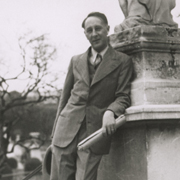With the publication of the full score and parts of the Rhapsodie, a one-movement symphonic work by Bohuslav Martinů dating from 1928, Bärenreiter presents the first published edition of this work.
Compositions for large orchestra can be found in all creative periods of Bohuslav Martinů’s life. From his first attempts at composition he was attracted to the idea of symphonic writing, but he only attached any real significance to works which were composed after his departure for Paris in 1923. By the end of the following year, the premiere of his piece Half-time, inspired by a football game, took place in Prague, conducted by Václav Talich. This was the first part of a trilogy of one-movement orchestral compositions. Two years later followed La Bagarre, premiered in November 1927 by Serge Koussevitzky with the Boston Symphony Orchestra.
The great success the performance of La Bagarre had in Boston, other American cities and further afield, encouraged Martinů to try his hand at larger forms. On the occasion of the tenth anniversary of the presentation of flags to the
1st Czechoslovakian Regiment in the French municipality of Darney, which preceded the official recognition of an independent Czechoslovakian state, Martinů decided to compose a symphony which was military in character. But he only got half way through the project: from his incomplete attempt, the original one-movement symphonic Allegro La Symphonie resulted, which was performed under this title for the first time on 14 December 1928 by Serge Koussevitzky in Boston. Martinů rated his new composition very highly and did not shy away from describing it as “one of my best things”. In the following years the work was universally enthusiastically received. After the Prague premiere on 12 March 1930 conducted by Ernest Ansermet, Martinů decided to rename the piece, evidently because its form and character did not correspond with that of a symphony. The Paris public heard it in April 1930 in a performance with Walter Staram and his orchestra under the title Allegro symphonique, and later the same year Martinů decided on the final title, Rhapsodie. Nevertheless, he still referred to the piece as the Symphonie militaire in his autobiography at the beginning of the 1940s.
The Rhapsodie symbolises one of the breaks in Martinů’s output. The composition ended the Parisian “dynamic stage”, as he himself called it, and until 1942, the year of his first symphony, he only returned to writing for large orchestra in Inventions, the opera Juliette and the new version of the ballet Špalíček. As with Half-time and La Bagarre, Rhapsodie combines inspiration through a rich use of brass instruments, and secondly, marks the beginning of Martinů’s next creative phase.
The three-part Rhapsodie, with its melodious and sparsely-scored Andante central section, strongly contrasting with the striking introductory Allegro and its condensed repetition, embellishes an inventive harmony and “apparent unisons” with a semitone dissonance – one of the main characteristics of Martinů’s style in the 1930s. A lyricism with distinctive rhythmic elements is immediately striking, and contrapuntal elements are also used. The concertante character of the instrumental groups also reflects the composer’s growing interest in the principles of the concerto grosso.
Despite its undoubted originality, freshness and impact, the initial success of the Rhapsodie unfortunately did not last. The composition, now forgotten, is therefore ripe for rediscovery. The new edition will make this considerably easier (it takes into account the two surviving autograph full scores in Kassel and Polička), and has been prepared by Bärenreiter-Verlag in collaboration with the Bohuslav Martinů Institute Prague. Performance material is available from the Hire Department of the publisher.
Marek Pechač
(translation: Elizabeth Robinson)
(from [t]akte 1/2012)



